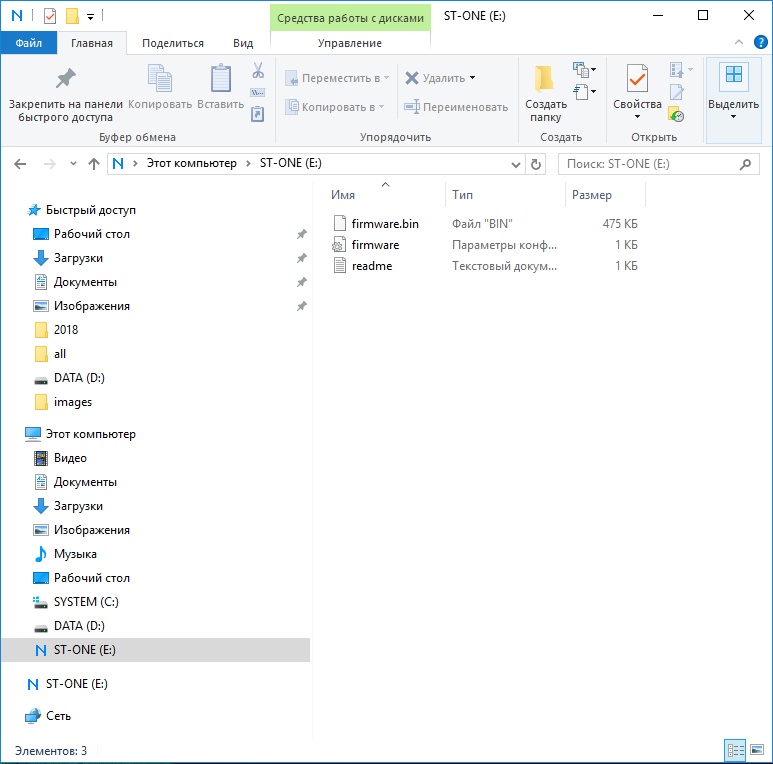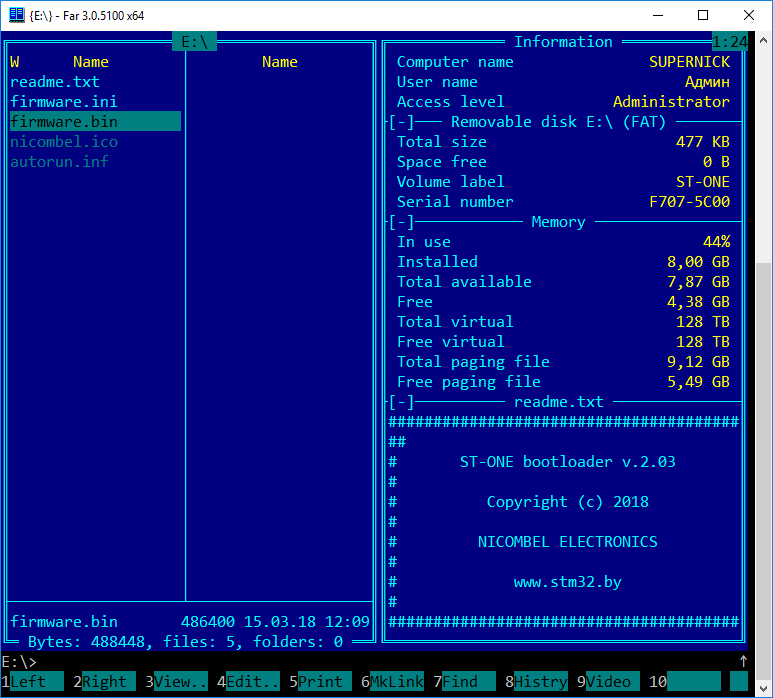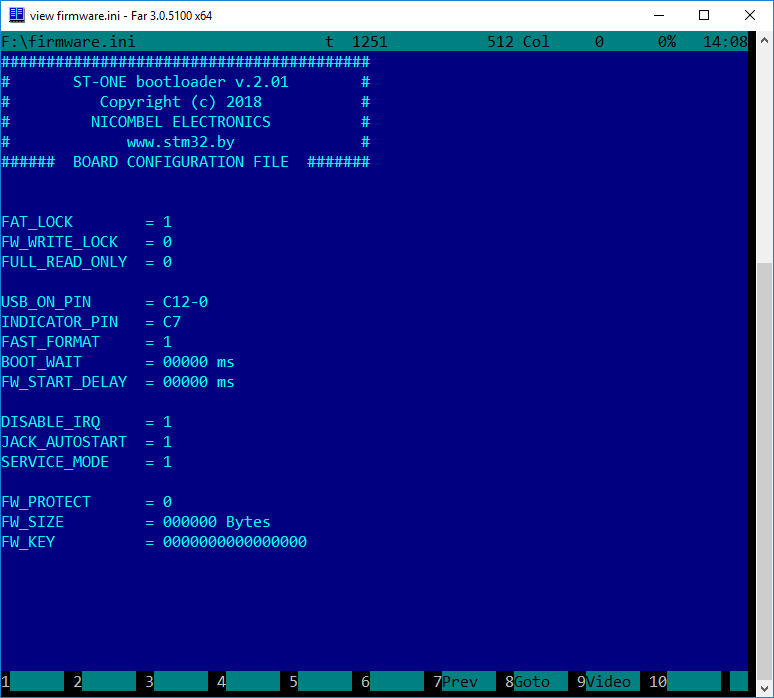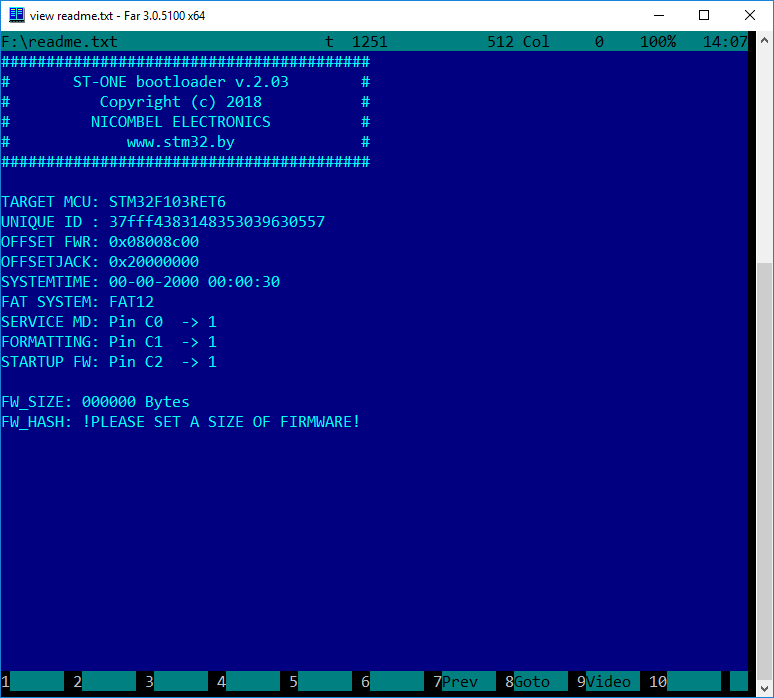ST-ONE
micro-embedded STM32!
 Русский
Русский
 English
English
Micro-platform for electronic devices based
on the ARM processor
Play 

ST-ONE has its own file system. When connected to a computer or smartphone, another disk or memory
card will appear in the system. Thus, you can update the firmware, make the necessary initial settings
for starting the device and perform other operations in the service mode.
The file system of the loader is a set of files and has a number of important qualities. The file system is based on the FAT12 standard. This gives backward compatibility with a huge variety of operating systems. But it's not the classic FAT. The ST-ONE file system is much more compact and has a number of advantages such as: READONLY mode control; file allocation table protection; transparent work with remap clusters and addresses and some other tricky gimmicks.
Since FAT of bootloader is not standard - formatting with utilities of the operating system is not allowed. The disk may be formatted incorrectly and the device may not work properly. Therefore, formatting with standard utilities is prohibited at the hardware level and will not bring the expected result. With this done some of the clusters can be zeroed. If there is a need to format the file system, in order to bring it to its original appearance or guaranteed to erase the firmware and other user data - use the system formatting function, called with software or hardware of the device.
The file system is a transparent reflection of the FLASH memory of MCU!
When you connect ST-ONE to a computer with Windows operative system you can see the following window:

As you can see in the Picture above, the file system consists of 3 main files. The device has a brand icon N and the label ST-ONE, which easily highlights it in the list of devices and disks of the file system of the computer.
In fact, the file system is somewhat wider. And it has system and hidden files. You can see them, for example, using File Manager.

Thus, we have a file system consisting of 5 files.
| File | Size, bytes | Purpose |
|---|---|---|
| readme.txt | 512 | Generated information file |
| firmware.ini | 512 | File of configuration of boot loader and firmware in the INI format |
| firmware.bin | 486 400 | Firmware file. The main microprogramm |
| nicombel.ico | 512 | Icon (logo) of boot loader |
| autorun.inf | 512 | Description autorun-file for Windows file systems and other |
This kind of system is after hardware formatting. The appearance and structure of files may vary slightly depending on the version of the loader.
As can be seen from the table above, the size of the main firmware can reach significant sizes - 486 400 bytes, which is equal to 475 Kb of the maximum possible 512 Kb of FLASH memory provided by the microcontroller.
There may be more files, and the firmware may consist of many files, depending on the configuration of the device. In this case, the total size of the firmware files should not exceed the size of 475 Kb - that is, the space reserved for the main firmware.
Deletion or change of system files of the bootloader i.e. of icon and autorun are not assumed with regular means. Files are "system" and in most operating systems or file managers will be simply hidden, which will not interfere with the work with the loader.
Interesting for the user may be the rest two files firmware.ini and readme.txt.
This is the main boot loader configuration file. It contains important information, system start parameters, allows you to license the software, as well as perform hardware tweak-set pins of indication, USB control, lock or unlock the service mode, set protection.
FIRMWARE.INI has a standard INI file format, is intuitive and can be edited with any text editor. You can save changes by simply saving the file, and the specified settings will be applied at the next system start.

There is an agreement: the case of characters when working with the configuration file must be LARGE, and the file size can not exceed 512 bytes.
The agreement was adopted in order to eliminate the implementation of more complex configuration processing mechanisms and reduce the volume of the loader. In the rest it is the most common INI-file and the definition of parameters is carried out on the principle: [PARAMETER]=[VALUE]
For a more detailed description of file parameters and its directives, see the special section or documentation.
The file contains information about the current system. It is formed dynamically and is generated for each chip and version of bootloader automatically. Readme.txt contains information about the version of the loader, the model of the controller on which it works, a unique code of the UniqueID chip, which was assigned to each chip during production and is not subject to change.

In the information file, you can see the calculated values of entry points for the main firmware and service JACK-routines. This will allow you to immediately create software for ST-ONE without contacting third parties for information for your bootloader. The OFFSET parameters must be passed to the compiler when building software for the MCU.
Also the same file contains other system information. Description of the parameters you can find in the relevant section of the site or documentation.
